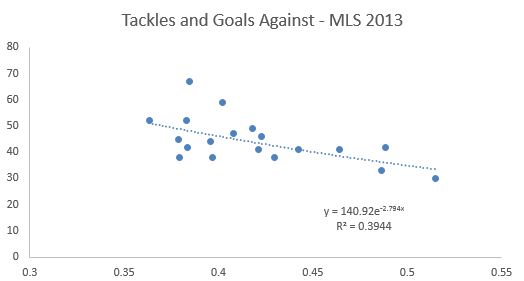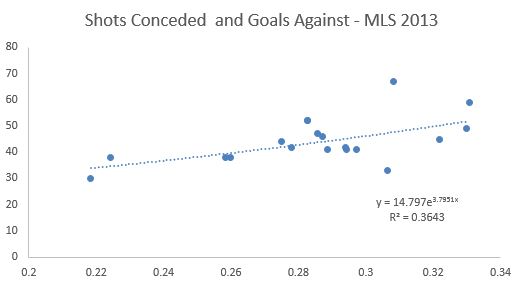Aye... the NFL track 'hurried throws' - why doesn't a Statistics agency involved in Soccer track "Hurried Passes"?
I'll get to that but first I need to set some conditions.
If you've read my article on Expected Wins (XpW) it seems reasonable that a teams' Passing Accuracy in the Final Third has great value in working towards generating quality shots taken that are more likely to be on goal and (therefore) more likely to go in.
So what activities does the defense take to mitigate successful passes (i.e. generate Unsuccessful Passes)?
Before digging in, I'm not the only one on American Soccer Analysis looking into Defensive Statistics; Jared Young has put together an interesting article on Individual Defensive Statistics that may be of interest.
Similarities in our work come from collecting 'like' defensive activities; Tackles Won, Clearances, Interceptions, etc...
Additional twists in my efforts will be to fold my Opponent team attacking statistics in with my team Defense Activities to see what correlations might be present.
My data comes from the first 71 games in MLS this year (142 events) and my source is the MLS Chalkboard.
Bottom line up front (BLUF) - however this data plays out it needs to make sense so here's my operating conditions on Team Defensive Activities in the Defending Final Third and which ones I will focus on that can be associated with an Unsuccessful Pass in the Final Third:
- Recoveries - usually associated with 'loose balls' generated from some other activity like a deflection, rebound, or perhaps an unsuccessful throw-in that hits a head and deflects away (uncontrolled) that another player latches on to and then makes a move showing control the ball. Therefore Recoveries are not counted as a specific defensive activity that would impede a successful pass - it is the resultant of another activity that impedes a successful pass.
- Clearances - one of the better examples of a defensive activity that impedes a successful pass - especially those generated from crosses but not necessarily called a blocked cross. Therefore Clearances will be counted as a specific defensive activity that impedes a successful pass.
- Interceptions - pretty much self explanatory - an interception impedes a successful pass - therefore Interceptions will be counted as a specific defensive activity that impedes a successful pass.
- Tackles Won - this is a defensive activity that strips the ball from an opponent - so it is a possession lost but not a defensive activity that impedes a successful pass. It won't be counted as a defensive activity that impedes a successful pass.
- Defender Blocks - this is a defensive activity that blocks a shot taken not a successful pass; therefore it won't be counted as a defensive activity that impedes a successful pass.
- Blocked Crosess - clearly it is what it is; and since a cross is a pass it will be counted as a defensive activity that impedes a successful pass.
To summarize - Blocked Crosses, Interceptions and Clearances will be counted as defensive activities that should impact the volume of Unsuccessful Passes.
So what are the correlations between those combined Defensive Activities versus Unsuccessful Passes after 142 events?
Final Third Defensive Activities to Unsuccessful Passes = .6864
Final Third Defensive Activities to Unsuccessful Passes when the Defending Activities' Team Wins = .7833
Final Third Defensive Activities to Unsuccessful Passes when the Defending Activities' Team Draws = .6005
Final Third Defensive Activities to Unsuccessful Passes when the Defending Activities' Team Loses = .6378
In conclusion:
It seems pretty clear that Teams who win have more Defensive Activities, that in turn increase their Opponents' Unsuccessful Passes given the higher positive correlation than losing teams - in other words a team that wins generally executes more clearances, interceptions and blocked crosses to decrease the number of Successful Passes their Opponents make.
It also seems pretty clear that all those Defensive Activities don't account for the total of Unsuccessful Passes generated by the Opponent. If they did then the correlation would be higher than .7833; it'd be near .9898 or so.
So what is missing from the generic soccer statistical community to account for the void in Unsuccessful Passes?
Is it another statistic like Tackles Won, Duals Won, Blocked Shots or Recoveries?
I don't think so - none of them generated a marked increase in the overall correlation of those three Activities already identified.
I think it is the physical and spatial pressure applied by the defenders as they work man to man and zone defending efforts.
In Closing...
To date I'm not aware of any statistics that log 'pressure applied' to the attacking team. A good way to count that would be tracking how many seconds the defending team gives an opponent when they recieve the ball and take action.
My expectation is that the less time, given the opponent, the more likely they will hurry a pass that simply goes awry without any other statistic event to account for that other than - bad pass due to being hurried.
So in other words; like the NFL tracks hurried passes, I think that the Soccer statistical community should also track "hurried passes"...
I'm not sure that completely closes the gap between those three Defensive Activities and Unsuccessful Passes but it does seem to be a relevant statistic that can attempt to quantify panic in an attacker while also quantifying good physical and spatial pressure by a defender. Two relevant items of interest to a coach in weighing the balance on who plays and who doesn't and who they might like to add to their team or perhaps put on loan/trade elsewhere.
The Official statistic that would get tracked for attacking players is 'Hurried Passes' and the statistic that would get tracked for defensive players is 'Passes Hurried'.
In addition - an increase in hurried passes can become a training topic that drives a Head Coach to develop tailor made passing or turning drills to minimize Hurried Passes (make space) while also providing a Head Coach statistical information to generate tailor made defensive drills that look to increase Passes Hurried. I'd expect the level of the training drills to vary given the level of skill/professional development as well.
So how might someone define a "Hurried Pass"? I'm not sure; there are plenty of smarter people out there in the soccer community than me - if I had to offer up a few suggestions it might be a pass that goes out of bounds given defensive pressure, or maybe a through-ball that goes amiss given pressure from a defender - in other words the timing of the delivery looked bad and given defensive pressure it was off-target.
However defined if judgment can be applied when identifying a pass as a key pass then it stands to reason that judgment can be applied to identify a bad pass as being bad because the defender hurried the attacker.
More to follow...
Best, Chris







